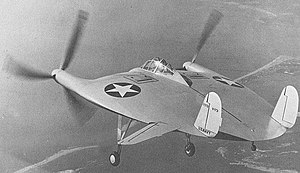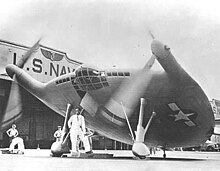Vought V-173
| V-173 | |
|---|---|

| |
| Role | Experimental aircraft |
| Manufacturer | Vought |
| First flight | 23 November 1942 |
| Retired | 15 March 1947 |
| Number built | 1 |
| Developed into | Vought XF5U |
The Vought V-173 "Flying Pancake" was an American experimental test aircraft built as part of the Vought XF5U program during World War II.
Both the V-173 and the XF5U featured an unorthodox "all-wing" design consisting of a flat, somewhat disk-shaped body (like a
Design and development
In the 1930s, Charles H. Zimmerman was a noted aeronautical engineer who advocated the concept of "discoidal" aircraft, the so-called "Zimmer Skimmer"[3] and worked on a variety of projects on his own and with the Vought company. After testing using scale models, including a remotely controlled, electrically powered large-scale model, designated the Vought V-162, the US Navy approached Zimmerman and offered to fund further development. Data and concept documentation was given to the Navy in 1939, with wind tunnel tests on full-scale models being completed in 1940-1941.
The original prototype, designated the V-173 (Flying Pancake), was built of wood and canvas and featured a conventional, fully symmetrical

The disc wing design featured a low aspect ratio that overcame the built-in disadvantages of

Zimmerman chose to include the all-moving stabilizer design because he realized that the increased drag, prop wash, and large wing area would make the aircraft difficult to control at low speeds.[7] Wind tunnel tests would prove that this was a success to an extent. The aircraft would prove to require a lot of force to control at low speeds during in-flight testing but the tail design would prove to make the aircraft controllable.[8]
In January 1942, BuAer requested a proposal for two prototype aircraft of an experimental version of the V-173, known as the VS-135. The development version, the Vought XF5U-1, was a larger aircraft with all-metal construction, and was almost five times heavier.[9] Although a prototype was constructed, it only performed brief hops on the runway, it never entered true controlled flight.[6]
Operational history

The first flight of the V-173 was on 23 November 1942 with Vought Chief Test Pilot
The developmental V-173 made its last flight 31 March 1947. In 131.8 hours of flying over 190 flights, Zimmerman's theory of a near-vertical takeoff- and landing-capable fighter had been proven.
Aircraft on display



As of April 2012, after undergoing a long restoration by Vought Aircraft Heritage Foundation volunteers, the V-173 is on loan from the Smithsonian Institution to the Frontiers of Flight Museum in Dallas, Texas.[15][16][17][18]
Specifications (V-173)
General characteristics
- Crew: One, pilot
- Length: 26 ft 8 in (8.128 m)
- Wingspan: 23 ft 4 in (7.1 m)
- Height: 14 ft 9 in (4.51 m)
- Wing area: 427 sq ft (44.2 m2)
- Gross weight: 2,258 lb (1,024 kg)
- Powerplant: 2 × Continental A-80horizontally opposed, four-cylinder engines, 80 hp (60 kW) each each
Performance
- Maximum speed: 138 mph (222 km/h, 120 kn)
- Climb time to 5,000 ft (1,500 m): 7 min
See also
Related development
Aircraft of comparable role, configuration, and era
Related lists
- List of fighter aircraft
- List of military aircraft of the United States
References
- Notes
- ^ Chant 1984, p. 53.
- ^ Winchester X-Planes 2005, p. 223.
- ^ Pearson 2002, p. 50.
- ^ Schoeni 1975, p. 568.
- ^ Naval Fighters Number Twenty One Chance Vought V-173 and Xf5U-1 Flying Pancakes. Steve Ginter. 1992. pp. 1, 9, 10, 11.
- ^ a b "Vought V-173 "Flying Pancake"". National Air and Space Museum, Smithsonian Institution. 1998. Retrieved 27 September 2020.
- ^ Naval Fighters Number Twenty One Chance Vought V-173 and Xf5U-1 Flying Pancakes. Steve Ginter. 1992. pp. 3, 4, 6.
- ^ Naval Fighters Number Twenty One Chance Vought V-173 and Xf5U-1 Flying Pancakes. Steve Ginter. 1992. p. 8.
- ^ Winchester Concept Planes 2005, p. 247.
- ^ Schoeni, Thomason, Clendenin, Lawson, Williams, Swisher, Larkins, Jansson, Downey, Kawalsk, Art, Tomy, Ed, Bob, Nick, William, William, Clay, Ron, bob (1992). Naval Fighters Number Twenty One Chance Vought V-173 and Xf5U-1 Flying Pancakes (1 ed.). Steve Ginter. p. 8.
{{cite book}}: CS1 maint: multiple names: authors list (link) - ^ Winchester X-Planes 2005, p. 222.
- ^ Ginter 1992, p. 11.
- ^ Ginter 1992, p. 8.
- ^ Guyton 1991, p. 29.
- ^ "Chance Vought V-173 "Flying Pancake" | Frontiers of Flight Museum". Flightmuseum.com. 23 November 1942. Archived from the original on 26 November 2013. Retrieved 29 May 2013.
- ^ "V-173 Flying Pancake". Vought Heritage. Retrieved 27 December 2016.
- ^ Lee, Russell (20 March 2012). "Vought Aircraft Heritage Foundation Retirees Finish Vought V-173 "Flying Pancake" Following 8-Year Restoration Effort". Smithsonian National Air and Space Museum. Retrieved 2 March 2017.
- ^ Wright, Tim (November 2013). "Restoration: Vought V-173". Air and Space. Retrieved 2 March 2017.
- Bibliography
- Chant, Christopher. Fantastic Aircraft. New York: Gallery Books, 1984. ISBN 0-8317-3189-3.
- Ginter, Steve. Chance Vought V-173 and XFU-1 Flying Pancakes (Naval Fighters Number Twenty-one). Simi Valley, CA: Steve Ginter Publishing, 1992. ISBN 0-942612-21-3.
- Guyton, Boone T. "The Flight That Must Not Fail, In the Strangest Flying Machine of All - The V-173." The Hook - Journal of Carrier Aviation Vol. 19, no. 4, Winter 1991. ISSN 0736-9220.
- Guyton, Boone and Paul Marcus. "The Ups and Downs of The Flying Pancake." True, July 1951. Vol. 29, no. 170.
- Guyton, Boone T. Whistling Death: The Test Pilot's Story of the F4U Corsair. Atglen, PA: Schiffer Publishing Ltd., 1996. ISBN 0-88740-732-3.
- Jerram, Michael E. Incredible Flying machines: An Anthology of Eccentric Aircraft. New York: Exeter Books, 1980. ISBN 0-85685-835-8.
- Pearson, Gregory. "Vought's Flying Disc." Wings Vol. 32, no. 1, February 2002.
- Schoeni, Art. "The Flying Pancakes." Aeroplane Monthly Part 1 Vol. 3, no. 11, November 1975, Part II, Vol. 3. no. 12, December 1975.
- Schoeni, Art. "The Flying Pancakes." Air Classics Vol. 11, no. 8, August 1975.
- Winchester, Jim. ""Vought XFU-1." Concept Aircraft: Prototypes, X-Planes and Experimental Aircraft. Kent, UK: Grange Books plc., 2005. ISBN 978-1-84013-809-2.
- Winchester, Jim. "Vought V-173 and XFU-1 'Flapjack' (1942)". X-Planes and Prototypes. London: Amber Books Ltd., 2005. ISBN 1-904687-40-7.
External links
![]() Media related to Vought V-173 at Wikimedia Commons
Media related to Vought V-173 at Wikimedia Commons
